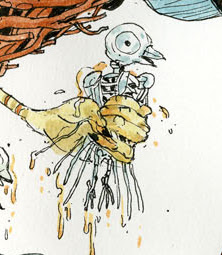Illustrator John Hendrix draws in church. Over the years, he has has compiled an impressive collection of church sketchbooks, many of which he has posted on his web site. Writes Hendrix:
I attend church every Sunday, and I draw during the sermon. All of these pages were done in a pew.... Simultaneous drawing and listening transforms familiar language into something new- a feedback loop of symbols, theology and wonder.
Paul Klee said, "Drawing is taking a line for a walk." In a sketchbook, sometimes the line takes you for a walk.
When it does, it can take you to lands where client specifications rarely go. Hendrix notes:
Drawing in my sketchbook is the very best part of my work. I love it because it is linear improvisation. Much like jazz, it is unpredictable, exciting and unfiltered.But there's another reason I especially like Hendrix's sketchbooks. Perhaps because of the soundtrack, his drawings often muse over great big subjects:

In the words of William Blake,
Great things are done when men and mountains meet;I have a special fondness in my heart for pictures that attempt big, unfashionable subjects-- life and death, injustice, war and peace.
This is not done by jostling in the street.
Artists illustrating "the place where men and mountains meet" frequently lapse into pretentiousness and melodrama, but Hendrix's sketchbooks avoid that pitfall. His sketchbooks are not dense, linear philosophical treatises. As a result of his stream-of-consciousness approach, cosmic words and symbols weave in and out of his designs in a light and elegant dance. Definitely worth a look.























